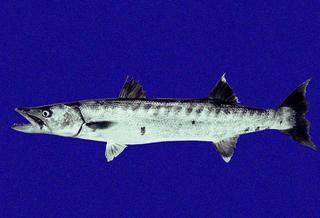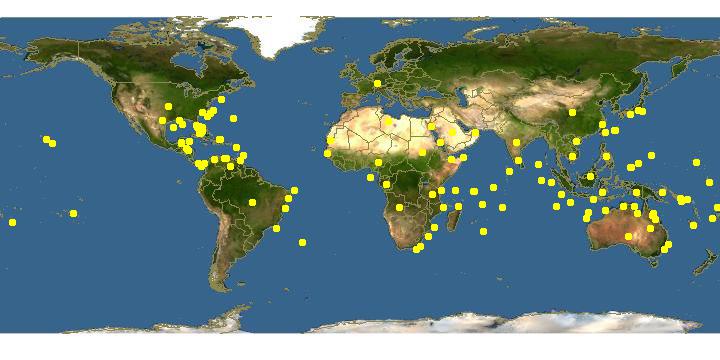|
| Links |
We parsed the following live from the Web into this page. Such content is managed by its original site and not cached on Discover Life. Please send feedback and corrections directly to the source. See original regarding copyrights and terms of use.
- Australian Faunal Directory
- FishBase
|
|
español |
|
|
Overview |
Main identification features
- ~20 dark bars + scattered black blotches
- 2nd dorsal fin anal fin c: dark, white tips
- c: lobes in center
- lateral line has 75-85 scales
Body elongate, cylindrical, robust; long head with long, pointed snout; mouth large, horizontal, lower jaw longer; jaws and roof of mouth with large, pointed, erect, compressed teeth; two well separated dorsal fins, first with V spines, second with 8 rays; anal 8 rays; pectoral 11-13 rays; tail forked, with central lobes, particularly in large fish; origin of pelvic fins under pectoral, before dorsal fin; lateral line complete, straight; scales smooth; 75-85 lateral line scales.
Mid-grey above, paler below, ~20 oblique dark bars on back, extending below lateral line at rear; dorsals, tail and anal fin blackish, with white contrasting tips; body with scattered irregular black blotches.
Size: 200 cm.
Habitat: coastal and oceanic, nearbottom to surface.
Depth: 0-25 m.
Atlantic and Indo-central Pacific; vagrant at the Galapagos and western Panama.
Attributes
Abundance: Common.
Cites: Not listed.
Climate Zone: Equatorial (Costa Rica to Ecuador + Galapagos, Clipperton, Cocos, Malpelo).
Depth Range Max: 25 m.
Depth Range Min: 0 m.
Diet: bony fishes; octopus/squid/cuttlefish; Pelagic crustacea.
Eastern Pacific Range: Northern limit=9; Southern limit=-2; Western limit=-93; Eastern limit=-82; Latitudinal range=11; Longitudinal range=11.
Egg Type: Pelagic; Pelagic larva.
Feeding Group: Carnivore.
FishBase Habitat: Pelagic.
Global Endemism: Circumtropical ( Indian + Pacific + Atlantic Oceans); East Pacific + Atlantic (East +/or West); Transisthmian (East Pacific + Atlantic of Central America); East Pacific + all Atlantic (East+West); All Pacific (West + Central + East); TEP non-endemic; "Transpacific" (East + Central &/or West Pacific); All species.
Habitat: Reef associated (reef + edges-water column & soft bottom); Water column; Estuary; Mangrove.
Inshore Offshore: Inshore; Inshore Only.
IUCN Red List: Not evaluated / Listed.
Length Max: 200 cm.
Regional Endemism: Continent; Island (s); Tropical Eastern Pacific (TEP) non-endemic; Eastern Pacific non-endemic; Continent + Island (s); All species.
Residency: Vagrant.
Salinity: Brackish; Marine.
Water Column Position: Mid Water; Near Bottom; Near Surface; Water column only;
|
|
|
Names | |
|
|
|
Links to other sites | |
|
|
|
References |
- Castro-Aguirre, J.L., 1999., Ictiofauna estuarino-lagunar y vicaria de México., Editorial Limusa S.A. de C.V.: 1-629pp.
- Edwards., 1771., Appendix. In Catesby, M. ed. The natural history of Carolina, Florida and the Bahama Islands; containing the figures of birds, beasts, fishes, serpents ... with their descriptions in English and French, etc. 3rd. ed. 2 vols., Appendix 20pp.
- Fowler, H.W., 1916., Cold-Blooded Vertebrates from Costa Rica and the Canal Zone., Proc. Acad. Nat. Sci. Phila., 68:389-414.
- Günther, A., 1864., On some new species of Central American fishes., Proc. Zool. Soc. London, 14:227-232.
- Meek , S.E. and Hildebrand, S.F., 1923., The marine fishes of Panama. Part I., Field Mus. Nat. Hist., Zool. Ser. Publ., XV:1-330.
- Smith , M. M. and Heemstra, P., 1986., Smith's Sea Fishes. Johannesburg: Macmillan South Africa. 1047 pp., Macmillan South Africa:1047pp.
- Walbaum, J. J., 1792., Petri Artedi Sueci Genera piscium. In quibus systema totum ichthyologiae proponitur cum classibus, ordinibus, generum characteribus, specierum differentiis, observationibus plurimis. Redactis speciebus 242 ad genera 52. Ichthyologiae, pars iii., Artedi Piscium, (Pt. 3):1-723.
|
|
|
Acknowledgements | |
I thank Ashley MacDonald and John Pickering, University of Georgia, for technical support in building this page.
|
|
| Supported by | |
|
Following modified from Australian Faunal Directory
|
Top | See original
| &pull 20q v5.145 20180528: Error 301 Moved Permanently http://biodiversity.org.au/afd/taxa/62e2e85b-5f4d-4199-9ea8-0e340e0b572f/ |
|
Following modified from FishBase
|
Top | See original
http://www.fishbase.org/Summary/speciesSummary.php?genusname=Sphyraena&speciesname=barracuda ---> http://fishbase.de/Summary/speciesSummary.php?genusname=Sphyraena&speciesname=barracuda
http://fishbase.de/Summary/speciesSummary.php?genusname=Sphyraena&speciesname=barracuda ---> https://fishbase.de/Summary/speciesSummary.php?genusname=Sphyraena&speciesname=barracuda
&pull 20q v5.145 20180528: Error 500 Can't locate object method "new" via package "LWP::Protocol::https::Socket" https://fishbase.de/Summary/speciesSummary.php?genusname=Sphyraena&speciesname=barracuda |
Updated: 2024-04-24 01:22:35 gmt
|

